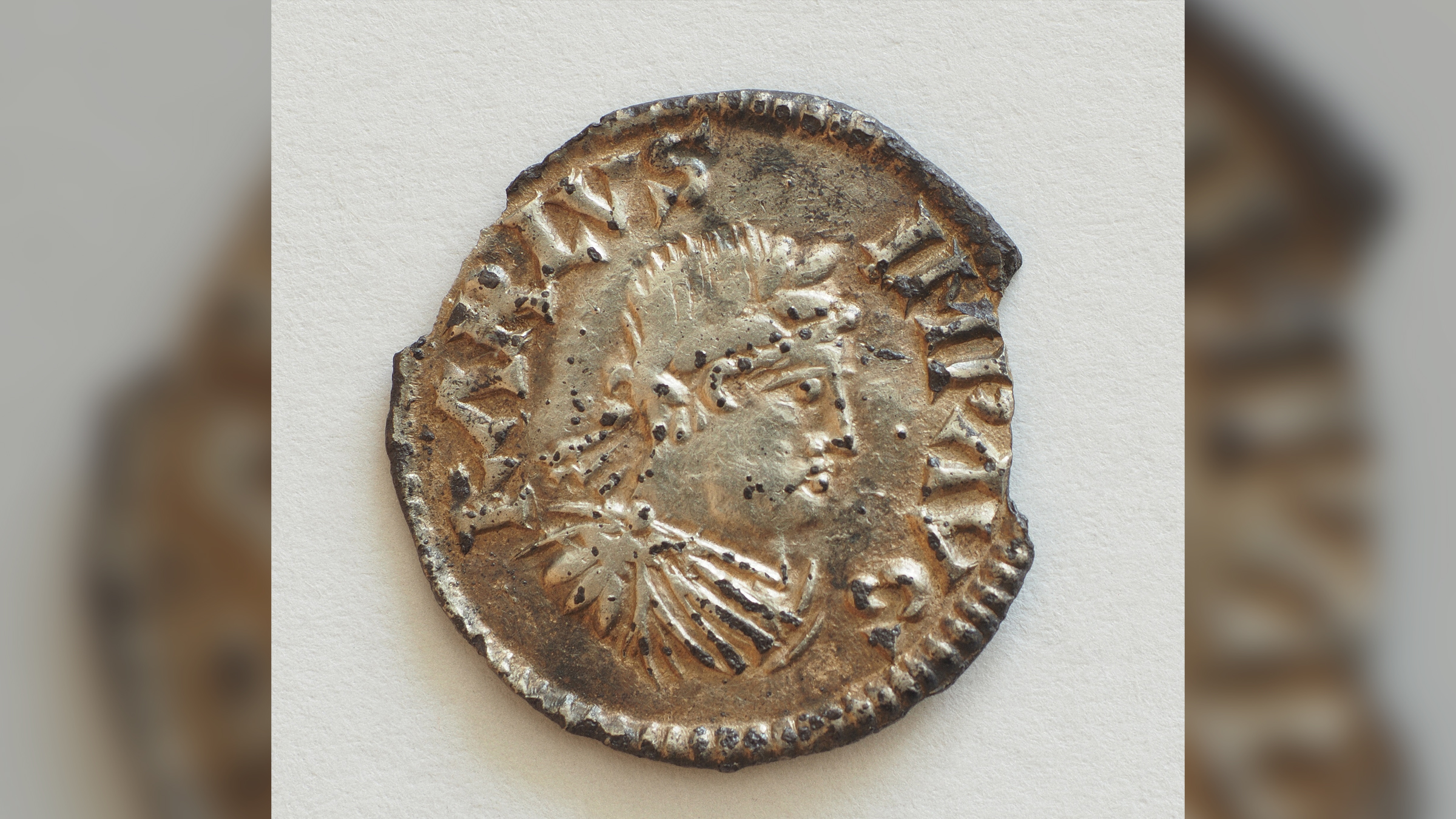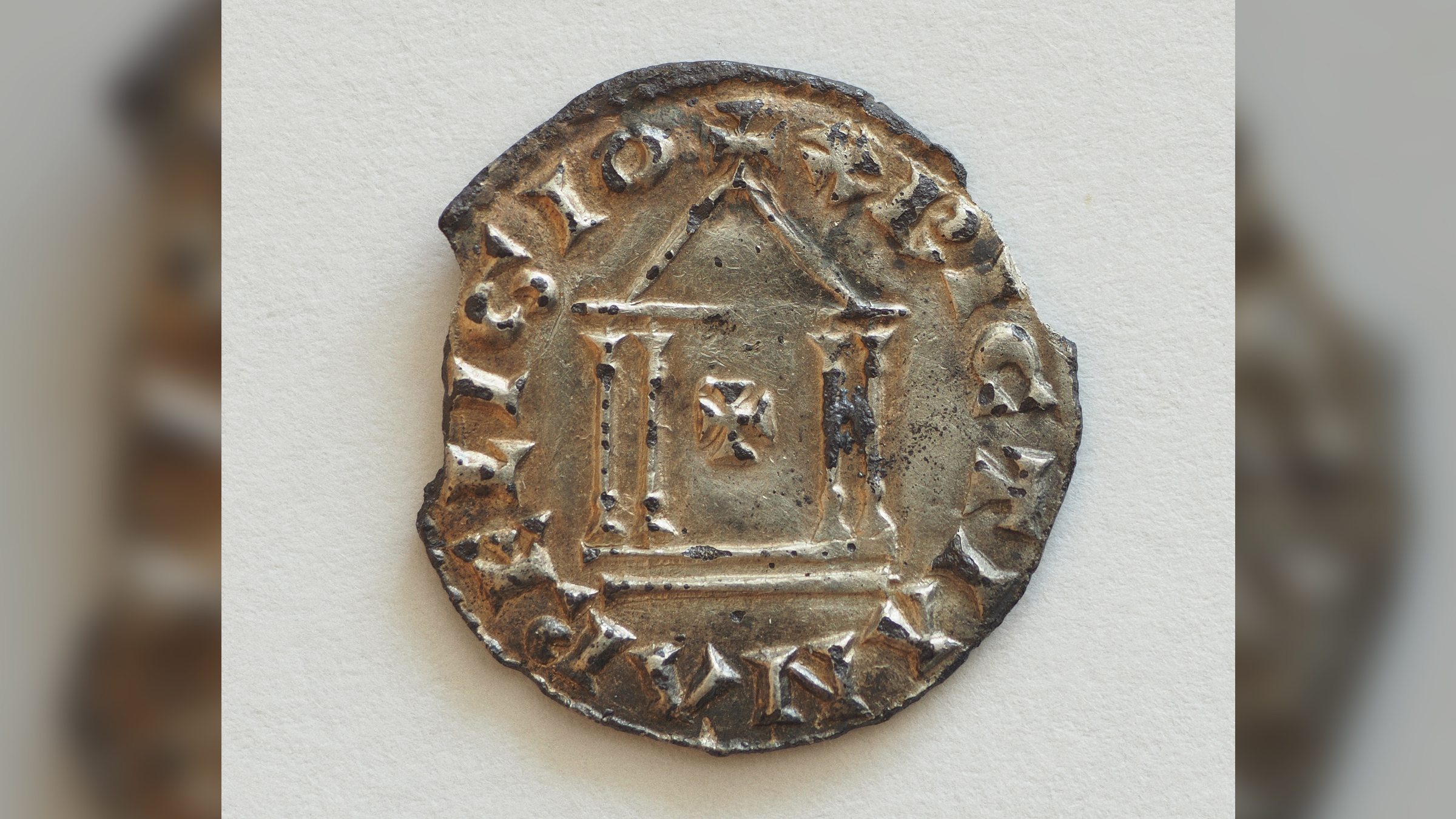French farmer finds rare coin featuring Charlemagne just before his death
The portrait confirms that Charlemagne had a short neck.

A rare 1,200-year-old silver coin featuring Charlemagne — one of the only known portraits made of the emperor during his lifetime — was recently rediscovered and promptly taken on a wild journey from a farm in France, to the bidding grounds of eBay and, finally, to a museum in Germany.
The coin's modern travels began when a man in France wanted to build a house but was short on cash. He remembered that he had inherited a coin collection from his grandfather, a farmer in the Paris region. After going through his grandfather's collection, the man discovered the Charlemagne coin, known as a denarius, and he put it up for auction on eBay.
"We have here some experts that regularly check what is on eBay concerning archaeology," said Frank Pohle, director of the Route Charlemagne, a group of municipal museums in Aachen, Germany, that focus on cultural history. "One of them told me 'Hey, there is a piece of money in eBay France that could be a real denarius of Charlemagne."
The museum decided to enter a bid. To their relief, they got the coin depicting Charlemagne and his imperial title: IMP(erator) AVG(ustus), a reference to Emperor Augustus, the first Roman emperor and a title used by the many emperors of the Roman Empire, whom Charlemagne was trying to emulate. (Pohle wouldn't reveal the coin's price, but said, "It was not that expensive. We are very content.")
Related: Amateur freedivers find gold treasure dating to the fall of the Roman Empire
Charlemagne (ruled A.D. 768 to 814), also known as Charles the Great, was king of the Franks and became the first ruler to unite Western and Central Europe after the fall of the Western Roman Empire in the fifth century A.D. Due to his political power, military might and close relationship with the Vatican, Charlemagne was crowned emperor of the Romans on Christmas day in A.D. 800.
So, perhaps it's no surprise that, in this coin portrait, Charlemagne "presents himself really as Roman emperor," Pohle told Live Science. "He has the laurel on his hat, which is quite unusual for Frankish kings. He is wearing a dress like a Roman general."
Sign up for the Live Science daily newsletter now
Get the world’s most fascinating discoveries delivered straight to your inbox.
The portrait also reveals that Charlemagne had a round face, a mustache and a short neck, the latter a detail noted by Charlemagne's biographer Einhard, Pohle said.
Putting his portrait on the 0.7-inch-diameter (1.9 centimeters) coin "has something to do with his ambitions," Pohle told Live Science. "That type of coin is quite a good copy of what the Roman emperors did in their times … to use money as a piece of their own marketing purposes."
There are only about 50 individual denarii coins bearing a portrait of Charlemagne created in his lifetime. "Most [denarii] only have his name on it, no portrait," Marjanko Pilekić, a numismatist and research assistant at the Coin Cabinet of the Schloss Friedenstein Gotha Foundation in Germany, who is not involved with the newfound coin, told Live Science.
The back of the coin features a building, which has a Christian cross on it and looks like a mix between a Roman temple and a church, Pohle said.

When was it minted?
Museum experts have determined that the 0.5-ounce (1.5 grams) coin was likely minted in Aachen due to the city's importance, as that's where Charlemagne was possibly born and later died. But the date of its minting is unclear. After being crowned Roman emperor, he didn't immediately use the title "Emperor Augustus" found on the coin.
"Although he was already crowned in 800, he didn't use that title [until] 812," Pohle said. "It had something to do with his diplomatic connections with Byzantium," also known as the Byzantine or Eastern Roman Empire. Instead, Charlemagne used the title "Emperor Governing the Roman Empire," according to Britannica.
Finally, in 812, the Byzantine Empire recognized Charlemagne's emperorship, so he started using the title found on the coin, making this a possible date for the coin's minting, Pilekić said. The coin also could have been minted in the year 813, when Charlemagne's son, Louis the Pious, was appointed as co-emperor and had similar coinage made.
"Charlemagne was ill during the last three to four years of his life, i.e. around 810-814, and was particularly concerned about the future of the empire," Pilekić said. "He had only one son left, whom he appointed co-emperor in 813. One theory is that the portrait coinage were created in the last year of his life. That is, at a time when he was probably striving for an orderly succession."
Another idea is that "these coins were specifically intended to commemorate the occasion of the emperor's coronation and therefore did not really serve as money like the other denarii of Charlemagne, which do exist in significantly larger numbers without a portrait and imperial title," Pilekić added.
It's hard to say how much this coin was worth at the time. "The amount of silver is quite low," but if you had 12 to 20 denarii, you could probably buy a cow, Pohle said.
Originally published on Live Science.

Laura is the archaeology and Life's Little Mysteries editor at Live Science. She also reports on general science, including paleontology. Her work has appeared in The New York Times, Scholastic, Popular Science and Spectrum, a site on autism research. She has won multiple awards from the Society of Professional Journalists and the Washington Newspaper Publishers Association for her reporting at a weekly newspaper near Seattle. Laura holds a bachelor's degree in English literature and psychology from Washington University in St. Louis and a master's degree in science writing from NYU.
